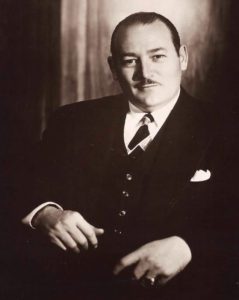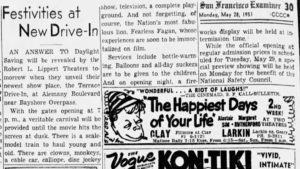Over the past several years, we have uncovered many impressive histories connected with Glen Park. One not yet discussed is the Glen Park connection to the glamor and glitz of Hollywood that began during the earliest days of Tinseltown. This post is Part 2 of 5.
…….
In Part 1 of this series, we saw yet another element of the long history of woman’s activism in Glen Park with the story of a female movie proprietor in a mostly male profession. So, what happened next at the Diamond Theatre?
Robert (“Bob”) Leonard (Lenard) Lippert was born in either San Francisco or Alameda County (depending on the source) in 1909 to Leonard Lippert, a confectioner, and Esther (née Meyers) Lippert, both first-generation Americans of German descent. In 1972, San Francisco Sunday Examiner and Chronicle Man on the Town columnist Jack Rosenbaum reported that in 1924 Lippert, just 14 years of age and living on Bartlett Street, had “rented an empty store at Diamond and Chenery and converted it to a movie house.” Lippert may have exaggerated the story a bit when he first shared it with Rosenbaum, as the “empty store at Diamond and Chenery” was likely the already extant Diamond Theatre. Also, Lippert’s stated age and year of the event appears to be a couple of years off as Caroline Evers, featured in Post 1, continued to manage the Diamond Theatre through 1925.
However, after not being listed in 1926, the Diamond Theatre does reappear in the San Francisco directory in 1927. It disappears again in 1929 (the same year talking pictures appear on the scene), this time for good. It may well be true that 18-year-old Bob Lippert, who was orphaned at the age of 15 and never wanted to work in his adopted father’s hardware store, was literally “running the show” in the final years of Glen Park’s Diamond Theatre. It is here where he began to learn the nuts and bolts of theater management and movie projection.

Through the Depression years, Lippert continued to work in theaters in San Francisco and Alameda, gaining as much experience as he could. In 1931 at the age of 22 and already recognized as a “bay city theater operator,” Lippert took over management of the Roxie Theater in Oakland for its reopening as a “talkie house.” By the start of World War II, Lippert owned a chain of 53 movie houses, Robert Lippert Theaters, throughout the Western United States and as far east as Paducah, Kentucky. He is noted in Who Was Who in America (Volume 5, 1977-1981) as having pioneered drive-in theaters. Two of Lippert’s drive-ins were within a short distance of Glen Park: the 700-car Terrace Drive-In at 451 Alemany Boulevard near Bayshore Boulevard, built in 1951 and demolished in 1956 (likely because of pending freeway construction of Interstate 280), and the 850-car El Rancho I and II Drive-In on Hickey Boulevard in South San Francisco that opened with one of the first FM sound transmission capabilities in 1949. The El Rancho remained open until the early 1980’s.

Claiming, “Every theater owner thinks he can make pictures better than the ones they sent him,” Lippert concurrently became involved with movie production. His first movie, a B-Western produced in 1945 under his fledgling company, Action Pictures, was distributed by his other new company, Screen Guild Productions. In 1947, he was serving as its vice-president. When Screen Guild became Lippert Pictures in 1949, he had already released about 125 B-films between the two companies. Most are forgettable works but his I Shot Jesse James with Preston Foster (1949) was a critical box office success. Other notables were The Baron of Arizona with Vincent Price (1950) and the Korean War drama, The Steel Helmet (1951). In 1953, he formed a partnership with his British distributor, Exclusive Films, which became known as Hammer Film Productions. The company released a series of successful film noir thrillers (learn more about film noir).
In 1956, film producer Daryl F. Zanuck tapped Lippert to run his Regal Pictures for making primarily lower-grade B movies, and he became famous for never going over budget. During this portion of his production career, Lippert collaborated with several well-known actors, including George Brent, George Raft, Veronica Lake, George Reeves, Robert Alda, Lloyd Bridges, and Leslie Howard. With a total filmography of more than 300 films, Lippert became known as “King of the Bs.” Perhaps his greatest success was the sci-fi classic, The Fly with Vincent Price (1958). Unfortunately, his role as executive producer is uncredited, having been replaced by Twentieth Century-Fox early in production due to an ongoing conflict with the Screen Actors Guild over residual payments.
Though he spent much of his time in Hollywood, Lippert always maintained a company office in his hometown of San Francisco. By the time of his death in Alameda in 1976, Lippert owned a chain of 118 movie theaters. Not too bad for a kid who once ran a Glen Park movie house. Read more about Lippert’s filmography, including several posters and images.
In Part 3, a major motion picture brings to life the daredevil achievement of an early 20th Century Fairmount resident who began his career in Glen Park.
Evelyn Rose, Director and Founder of the Glen Park Neighborhoods History Project, is documenting the histories of Glen Park and nearby neighborhoods. To learn more about our local histories, visit www.GlenParkHistory.org. The Glen Park Neighborhoods History Project is currently offering intermittent virtual programs during the ongoing health crisis. Join the mailing list: GlenParkHistory@gmail.com. The Glen Park Neighborhoods History Project is fiscally sponsored by Independent Arts & Media, a California non-profit corporation. Evelyn is also the author of the history website, Tramps of San Francisco.